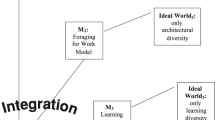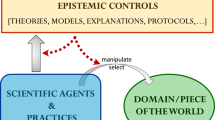Abstract
We introduce a new type of pluralism about biological function that, in contrast to existing, demonstrates a practical integration among the term’s different meanings. In particular, we show how to generalize Sandra Mitchell’s notion of integrative pluralism to circumstances where multiple epistemic tools of the same type are jointly necessary to solve scientific problems. We argue that the multiple definitions of biological function operate jointly in this way based on how biologists explain the evolution of protein function. To clarify how our account relates to existing views, we introduce a general typology for monist and pluralist accounts along with standardized criteria for judging which is best supported by evidence.


Similar content being viewed by others
Notes
Sabina Leonelli’s recent work on bio-ontologies does address the general importance and potential downfalls of standardized vocabulary for data packaging and integration, for example, but she doesn’t draw clear implications for conceptual analysis of single terms (Leonelli 2016).
Mitchell also gives in-principle reasons against theoretical unification for the social insect case, but we use a weaker condition that is based only on present knowledge.
Note that at the time of the duplication the gene is assumed to still be fulfilling the propensity functions for which it underwent selection in the past. Technically the gene therefore has two or more paired sets of evolutionary and propensity functions.
Havstad originally proposed the first four of these schemas in her manuscript, though we have revised their definitions in our presentation.
It is not clear what distinctions Saborido means to draw between approaches, theories, views, and definitions in the figure. We will interpret the hierarchy as relating definitions.
Walsh and Ariew in particular move ambiguously between attributing functions to parts and traits without clarifying whether their concept of trait also includes properties of whole systems (e.g. Walsh and Ariew 1996, p. 493, 501–502, 506).
References
Amundson R, Lauder GV (1994) Function without purpose. Biol Philos 9:443–469
Arenas M (2015) Trends in substitution models of molecular evolution. Front Genet 6(52):319
Artiga M (2011) Re-organizing organizational accounts of function. Appl Ontol 6(2):105–124
Autumn K, Ryan MJ, Wake DB (2002) Integrating historical and mechanistic biology enhances the study of adaptation. Q Rev Biol 77(4):383–408
Bechtel W (1993) Integrating sciences by creating new disciplines: the case of cell biology. Biol Philos 8(3):277–299
Bigelow J, Pargetter R (1987) Functions. J Philos 84(4):181–196
Binney N (2018a) The function of the heart is historically contingent. Stud Hist Philos Biol Biomed Sci 68–69:42–55
Binney N (2018b) The function of the heart is not obvious. Stud Hist Philos Biol Biomed Sci 68–69:56–69
Boorse C (1976) Wright on functions. Philos Rev 85(1):70–86
Boorse C (2014) A second rebuttal on health. J Med Philos 39(6):683–724
Boyd RN (1999) Homeostasis, species, and higher taxa. In: Wilson RA (ed) Species: new interdisciplinary essays. MIT Press, Cambridge, pp 141–185
Brandon RN (2013) A general case for functional pluralism. In: Huneman P (ed) Functions: selection and mechanisms. Springer Netherlands, Dordrecht, pp 97–104
Brigandt I (2003) Species pluralism does not imply species eliminativism. Philos Sci 70(5):1305–1316
Brigandt I (2009) The epistemic goal of a concept. Synthese 177(1):19–40
Brigandt I (2011) Natural kinds and concepts: a pragmatist and methodologically naturalistic account. In: Knowles J, Rydenfelt H (eds) Pragmatism, science, and naturalism. Peter Lang International Academic Publishers, Bern, pp 171–196
Brigandt I (2013) Integration in biology: philosophical perspectives on the dynamics of interdisciplinarity. Stud Hist Philos Biol Biomed Sci 44(4):461–465
Brigandt I, Love AC (2012) Conceptualizing evolutionary novelty. J Exp Zool Part B 318(6):417–427
Brigandt I, Rosario E (Forthcoming) Strategic conceptual engineering for epistemic and social aims. In: Burgess A, Cappelen H, Plunkett D (eds) Conceptual engineering and conceptual ethics. Oxford University Press, Oxford
Brigandt I, Steinle F (2012) The dynamics of scientific concepts. In: Feest U (ed) Scientific concepts and investigative practice. Walter de Gruyter, Berlin, pp 75–103
Bzovy J (2017) Species pluralism: conceptual, ontological, and practical dimensions. Electronic Thesis and Dissertation Repository. https://ir.lib.uwo.ca/etd/4309. Accessed 11 Apr 2019
Cummins R (1975) Functional analysis. J Philos 72(20):741–765
Currie A (2014) Marsupial lions and methodological omnivory: function, success and reconstruction in paleobiology. Biol Philos 30(2):187–209
Cuthill I (2005) The study of function in behavioural ecology. Anim Biol 55(4):399–417
Darden L, Maull N (1977) Interfield theories. Philos Sci 44(1):43–64
Dewey J (1938) Logic: the theory of inquiry. Irvington Publishers, Inc., New York
Dittmar K, Liberles D (2011) Evolution after gene duplication. Wiley, New York
Franz NM, Sterner BW (2018) To increase trust, change the social design behind aggregated biodiversity data. Database. https://doi.org/10.1093/database/bax100
Garson J (2016) A critical overview of biological functions. Springer International Publishing, Cham
Garson J (2017) How to be a function pluralist. Br J Philos Sci 69:1101–1122
Garson J, Piccinini G (2014) Functions must be performed at appropriate rates in appropriate situations. Br J Philos Sci 65(1):1–20
Gerson EM (2014) The interaction of research systems in the Evo-devo juncture. In: Love AC (ed) Conceptual change in biology, vol 307. Springer Netherlands, Dordrecht, pp 441–457
Godfrey-Smith P (1993) Functions: consensus without unity. Pac Philos Q 74:193–208
Godfrey-Smith P (1994) A modern history theory of functions. Noûs 28(3):344–362
Godfrey-Smith P (2009) Darwinian populations and natural selection. Oxford University Press, Oxford
Godfrey-Smith P (2013) Darwinian Individuals. In: Bouchard F, Huneman P (eds) From groups to individuals: perspectives on biological associations and emerging individuality. MIT Press, Cambridge
Hahn MW (2009) Distinguishing among evolutionary models for the maintenance of gene duplicates. J Hered 100(5):605–617
Hausman DM (2014) Health and functional efficiency. J Med Philos 39(6):634–647
Kay LE (2000) Who wrote the book of life? A history of the genetic code. Stanford University Press, Stanford
Kimura M (1985) The neutral theory of molecular evolution. Cambridge University Press, Cambridge
Kingma E (2010) Paracetamol, poison, and polio. Br J Philos Sci 61(2):241–264
Kingma E (2015) Situation-specific disease and dispositional function. Br J Philos Sci 67(2):391–404
Kitcher P (1981) Explanatory unification. Philos Sci 48(4):507–531
Kitcher P (1993) The advancement of science. Oxford University Press, New York
Kraemer DM (2013) Statistical theories of functions and the problem of epidemic disease. Biol Philos 28(3):423–438
Kraemer DM (2018) Philosophical analyses of scientific concepts. Philos Compass 13(9):e12513
Krohs U (2007) Functions as based on a concept of general design. Synthese 166(1):69–89
Leonelli S (2013) Integrating data to acquire new knowledge: three modes of integration in plant science. Stud Hist Philos Biol Biomed Sci 44(4):503–514
Leonelli S (2016) Data-centric biology: a philosophical study. University of Chicago Press, Chicago
Li W-H (1983) Evolution of duplicate genes and pseudogenes. In: Nei M, Koehn RK (eds) Evolution of genes and proteins. Sinauer Associates, Sunderland, pp 14–37
Love AC (2008) Explaining evolutionary innovations and novelties. Philos Sci 75(5):874–886
Love AC, Lugar GL (2013) Dimensions of integration in interdisciplinary explanations of the origin of evolutionary novelty. Stud Hist Philos Biol Biomed Sci 44(4):537–550
Lynch M, Katju V (2004) The altered evolutionary trajectories of gene duplicates. Trends Genet 20(11):544–549
Machery E (2009) Doing without concepts. Oxford University Press, Oxford
Mahner M, Bunge M (2001) Function and functionalism: a synthetic perspective. Philos Sci 68(1):75–94
Mayo DG (1996) Error and the growth of experimental knowledge. University of Chicago Press, Chicago
Millerand F, Ribes D, Baker KS, Bowker GC (2013) Making an issue out of a standard: storytelling practices in a scientific community. Sci Technol Hum Values 38(1):7–43
Millikan RG (2002) Biofunctions: two paradigms. In: Ariew A, Cummins R, Perlman M (eds) Functions: new essays in the philosophy of psychology and biology. Oxford University Press, Oxford, pp 113–143
Mitchell SD (1995) Function, fitness and disposition. Biol Philos 10:39–54
Mitchell SD (2002) Integrative pluralism. Biol Philos 17:55–70
Mitchell SD (2003) Biological complexity and integrative pluralism. Cambridge University Press, Cambridge
Moreno A, Mossio M (2015) Biological autonomy. Springer Netherlands, Dordrecht
Mossio M, Saborido C (2016) Functions, organization and etiology: a reply to artiga and martinez. Acta Biotheor 64(3):263–275
Mossio M, Saborido C, Moreno A (2009) An organizational account of biological functions. Br J Philos Sci 60(4):813–841
Neander K (1991) Functions as selected effects: the conceptual analyst’s defense. Philos Sci 58(2):168–184
Nickles T (1981) What is a problem that we may solve it? Synthese 47:85–118
Ohno S (1970) Evolution by gene duplication. Springer, New York
O’Malley MA, Soyer OS (2012) The roles of integration in molecular systems biology. Stud Hist Philos Biol Biomed Sci 43(1):58–68
O’Malley MA, Elliott KC, Burian RM (2010) From genetic to genomic regulation: iterativity in microRNA research. Stud Hist Philos Biol Biomed Sci 41(4):407–417
Perlman M (2009) Changing the mission of theories of teleology: DOs and DON’Ts for thinking about function. In: Krohs U, Kroes P (eds) Functions in biological and artificial worlds. The MIT Press, Cambridge, pp 17–36
Piatigorsky J (2007) Gene sharing and evolution. Harvard University Press, Cambridge
Pigliucci M (2003) Species as family resemblance concepts. BioEssays 25(6):596–602
Putnam H (1973) Meaning and reference. J Philos 70(19):699–711
Queloz M (2019) The points of concepts. Can J Philos 37(1):1–24
Ruse ME (1971) Functional statements in biology. Philos Sci 38(1):87–95
Saborido C (2014) New directions in the philosophy of biology: a new taxonomy of functions. In: Galavotti MC, Dieks D, Gonzalez WJ, Hartmann S, Uebel T, Weber M (eds) New directions in the philosophy of science. Springer International Publishing, Cham, pp 235–251
Saborido C, Mossio M, Alvaro M (2011) Biological organization and cross-generation functions. Br J Philos Sci 62(3):583–606
Saborido C, Moreno A, González-Moreno M, Clemente JCH (2016) Organizational malfunctions and the notions of health and disease. In: Giroux É (ed) Naturalism in the philosophy of health. Springer International Publishing, Cham, pp 101–120
Schaffner KF (1967) Approaches to reduction. Philos Sci 34(2):137–147
Ségurel L, Bon C (2017) On the evolution of lactase persistence in humans. Annu Rev Genomics Hum Genet 18(1):297–319
Walsh DM, Ariew A (1996) A taxonomy of functions. Can J Philos 26(4):493–514
Waters CK (2014) Shifting attention from theory to practice in philosophy of biology. In: Galavotti MC (ed) New directions in the philosophy of science. Springer International Publishing, Cham, pp 121–139
Wilson M (2006) Wandering significance. Oxford University Press, New York
Wimsatt WC (2013) Evolution and the stability of functional architectures. In: Huneman P (ed) Functions: selection and mechanisms. Springer Netherlands, Dordrecht, pp 19–41
Woodward J (2017) Scientific explanation. In: Zalta EN (ed) The Stanford encyclopedia of philosophy, Fall 2017 edition. https://plato.stanford.edu/entries/scientific-explanation/. Accessed 11 Apr 2019
Wouters AG (2003) Four notions of biological function. Stud Hist Philos Biol Biomed Sci 34(4):633–668
Wouters AG (2007) Design explanation: determining the constraints on what can be alive. Erkenntnis 67(1):65–80
Wright L (1973) Functions. Philos Rev 82(2):139–168
Acknowledgements
The idea for practice-oriented conceptual analysis first emerged from conversations Sterner had with Joyce Havstad and Scott Lidgard at the Field Museum, but the views we present here are our own and do not necessarily reflect their considered positions. We thank the organizers and participants of the Scientific Knowledge Under Pluralism conference at the University of Pittsburgh in 2017, and the University of Michigan’s Society of Fellows program for providing us with the time and support to collaborate on this project. We also thank the two anonymous referees for this manuscript who provided helpful and constructive responses.
Author information
Authors and Affiliations
Corresponding author
Additional information
Publisher's Note
Springer Nature remains neutral with regard to jurisdictional claims in published maps and institutional affiliations.
Rights and permissions
About this article
Cite this article
Cusimano, S., Sterner, B. Integrative pluralism for biological function. Biol Philos 34, 55 (2019). https://doi.org/10.1007/s10539-019-9717-8
Received:
Accepted:
Published:
DOI: https://doi.org/10.1007/s10539-019-9717-8




